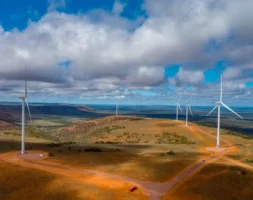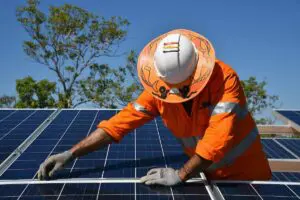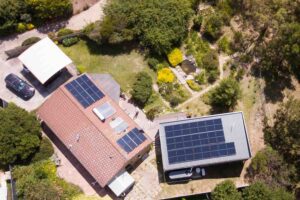Whilst many of us in Australia are focused on domestic politics and what the major parties are offering for energy policy to reduce greenhouse emissions, it is also important to consider what is happening to our northern neighbour, Indonesia, the world’s 4th most populous nation, if we are to have appropriate global action in combating climate change.
Indonesia currently consumes around 220TWh of electricity per year, marginally more than Australia’s National Electricity Market.
But it has a population of 264 million, or roughly ten times that of Australia. As a developing nation, the country is endeavouring to improve the living standard of Indonesians by increased electrification, bringing electricity to more of the population.
Presently, around 80% of the electricity consumed is within the interconnected Java-Bali and Sumatra systems, with the rest scattered across thousands of isolated systems mostly fueled by diesel generators with significant potential for PV generation and energy storage as a future replacement.
To better understand the Indonesian electricity system, Ariel Liebman of Monash University’s Grid Innovation Hub and myself performed a detailed study at the transmission level, focusing on the Java-Bali and Sumatra systems.
The purpose was to examine whether Perusahaan Listrik Negara (PLN – Indonesia’s government owned electricity supplier) needs to build its current pipeline of largely fossil-fueled generation projects over the next decade and whether it can significantly increase the share of renewable generation without significantly increasing costs and maintaining reliability in the system.
To examine this, Ariel and I have spent the last year developing and refining a model of the Indonesian electricity sector with input and assistance from Agora-energiewende (https://www.agora-energiewende.de) in Germany and Indonesia’s Institute for Essential Services Reform (http://iesr.or.id) and co-funded by the Australia-Indonesia Centre.
We established a detailed model of the 34 provinces within Indonesia and created hourly demand forecasts for each of these from 2018 until 2027, as well as limits on physical interconnection between these provinces, using the PLEXOS energy market modelling tool.
Our review of the PLN’s previous forecasts done annually and known as the RUPTL was utilised for elements of our work including their initial demand forecasts and details of the over 1,050 existing and planned power stations.
Assumptions were then made based upon real observations of the generation fleet about efficiencies, fuel costs, ramp rates, reliability and other factors to create a realistic model of the Indonesian electricity sector. It is understood that we have been the first to do a proper optimisation based approach using PLEXOS for this study.
Our first observation was that the PLN has significant forecast increases in both Java-Bali and Sumatra growth out to 2027. It was our opinion that these forecasts seemed unrealistically high given previous forecasts that had not been realised, and they did not appear to account for much improvement in household energy efficiency.
They also rely heavily upon the industrial sector, which makes up much of the load and forecast growth, and often relies upon single large projects to go ahead for these forecasts to be realised.
The initial modelling examined the build of generation as planned, and it is our view based on our results that there is likely to be a significant overbuild of generation capacity for both their current forecast energy needs, and a more conservative growth scenario, such as we have modelled.
Either of these outcomes mean an inefficient build of generation, higher system costs to Indonesia and the possibility of stranded generation assets.
Our focus however, was to examine alternatives to the existing planned build of mostly fossil-fueled plant and explore the opportunity for renewable generation sources such as solar, wind, geothermal and hydro generation.
Using available studies[1][2]on the potential availability of wind and solar we were able to locate where possible sites would be for these technologies whilst we utilised the RUPTL for hydro and geothermal opportunities.
[2]Peluang investasi dan potensi pengembangan Energi Baru Terbarukan Indonesia, Berdasarkan Peraturan Menteri ESDM Nomor 12 Tahun 2017, tentang Pemanfaatan Sumber Energi Terbarukan untuk Penyediaan Tenaga Listrik, Jakarta | 20 Februari
To identify more specific profiles of the potential of solar and wind we used Renewables Ninja[1], an online mapping tool that allowed us to examine the hourly potential resource of a number of representative sites in Java-Bali and Sumatra. Build costs for these technologies were reviewed and sourced from a number of academic studies.[2][3][4]
The model was then run under different scenarios where generation was built efficiently at minimal cost whilst still ensuring adequate supply of fast start generation and minimal unserved energy (i.e. when the lights go out). The following chart display what we would expect the system to run at in October 2018 with the information we have.
This shows much of the baseload supplied by coal and some geothermal, combined cycle gas generators making up the intermediate component, whilst open cycle gas turbines and hydro including pump storage supply energy at peak times, consistent with our expectations.
[2]Dr Thomas Schlegl Fraunhofer ISE Dr Christoph Kost, “Stromgestehungskosten Erneuerbare Energien,” May 15, 2018, 1–44.
[3]Bjarne Bach, “Technology Data for the Indonesian Power Sector,” December 18, 2017, 1–140
[4]Kaliapa Kalirajan and Arif Syed, “The Indonesian Energy Technology Assessment (Ieta) 2017,” November 2, 2018, 1–165.
Then we scrutinised the first whole week in October 2027, and utilising a scenario of significant build of renewable generation and more conservative demand growth, we can observe that after allowing for known retirement of coal and gas plants that geothermal, solar and wind make up a significant share of generation in that year, displacing coal whilst the need for peak generation is supplied by an increased share of hydro generation whilst both open cycle and combined cycle gas plant are used significantly less.
This is shown in the following chart.
What is important is that with these levels of renewables, there is neither significant “spill” or unused renewable energy, and that the inherent flexibility in the generation fleet is able manage any issues with the variability in renewable sources.
Looking at the modelling at a higher level and focusing on aggregate energy production we observe that only 19% renewable energy is generated by 2027 under the existing RUPTL plan, whilst our modelled scenarios of medium and high levels of renewables have 31% and 43% renewable generation in 2027, respectively.
Displaying the projected annual electricity sector emissions in 2027 and comparing the BAU scenario to higher renewables alternatives we observed reductions of between 39 and 89 MegaTonnes of CO2e.
Whilst emissions can be significantly reduced by introducing renewables, the cost of this conversion needs to be considered.
To answer this in our study, the total system costs were assessed for Java-Bali and Sumatra for the period 2018-2027, where the medium and high renewables scenarios saw increases of 4% and 7% respectively, and the “energy transition” scenario was one that utilised less conservative assumptions around the cost of new renewable generation, resulting in a 1% reduction as compared to business as usual.
This is only a brief review of our study, but it shows that Indonesia can introduce a much greater level of renewable generation as the population and electricity consumption increase over the next decade.
Renewables can make a greater share of the generation mix at similar or potentially lower cost than the status quo without reducing system reliability.
A detailed copy of the report can be found at: http://iesr.or.id/2019/02/technical-report-a-roadmap-for-indonesias-power-sector/?lang=en and an executive summary is located at: http://iesr.or.id/2019/02/summary-for-policy-makers-a-roadmap-for-indonesias-power-sector/?lang=en
We’d also like to thank Philipp Godron, Mentari Pujantoro, Fabby Tumiwa, Jannata Giwangkara and Agus Tampubolon for their assistance with this project.
Warwick Forster – Apogee Energy (www.apogeeenergy.com.au)
Ariel Liebman – Director, Monash Grid Innovation Hub


















